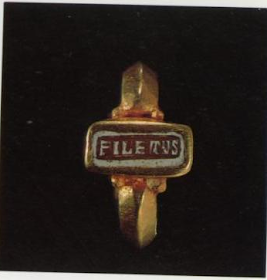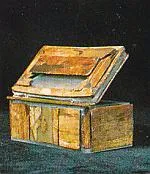Πετομηχανή
του Αρχύτα (440-360 π.Χ.). The flying pigeon of Archytas. It was the first
autonomous volatile machine of antiquity. It consisted of a light but powerful
shell that had the form of a pigeon and had internally the bladder of a big
animal. The aerodynamic pigeon was placed with the opening of the bladder
adapted to the utmost opening of a heated airtight boiler (or a powerful piston
air-pump). When the pressure of the steam or air exceeded the mechanical
resistance of the connection, the pigeon was launched and continued its flight
for some hundreds of metres with the help of the compressed air force coming
out of the bladder according to the principles of aerodynamics. SOURCES: "Aulus Gellius, Attic
Nights".
Στις
μέρες μας όλοι καταλαβαίνουμε τι πάει να πει η λέξη «ρομπότ» και έχουμε μια
εικόνα για το πώς μπορεί να μοιάζει και τι μπορεί να κάνει, είτε επηρεαζόμενοι
από τις ταινίες επιστημονικής φαντασίας, είτε μαθαίνονται νέα που σχετίζονται
με τις τεχνολογικές εξελίξεις.
Πότε
όμως δημιουργήθηκε το πρώτο ρομπότ;
Αρχύτας
ο Ταραντίνος: Ο αρχαίος Έλληνας μαθηματικός που κατασκεύασε το πρώτο ρομπότ
στην ιστορία της ανθρωπότητας. Archytas is believed to be the founder of mathematical
mechanics. As only described in the writings of Aulus Gellius five centuries
after him, he was reputed to have designed and built the first artificial,
self-propelled flying device, a bird-shaped model propelled by a jet of what
was probably steam, said to have actually flown some 200 meters. This machine,
which its inventor called The pigeon, may have been suspended on a wire or
pivot for its flight. Archytas also wrote some lost works, as he was included
by Vitruvius in the list of the twelve authors of works of mechanics. Thomas
Winter has suggested that the pseudo-Aristotelian Mechanical Problems is an
important mechanical work by Archytas, not lost after all, but misattributed.
Ο
Έλληνας Επιστήμων Αρχύτας ο
Ταραντίνος, που κατασκεύασε το πρώτο αεριωθούμενο αεροπλάνο στην ιστορία και
“έφερε” τη “βιομηχανική” επανάσταση πολύ νωρίτερα από την ώρα που επρόκειτο να
γίνει στο μέλλον, έστω και αν έζησε εκατοντάδες χρόνια πριν.
Bust from the Villa
of the Papyri in Herculanum, once identified as Archytas, now thought to be
Pythagoras. Archytas de Tarente. Buste provenant de la villa des Papyrus
d'Herculanum, aujourd'hui au Musée national archéologique de Naples.
Άγνωστος
για τους περισσότερους ανθρώπους, αφού δεν υπάρχει γι αυτόν αναφορά ούτε στα
σχολικά μας βιβλία, αποτελεί ένα από τα μεγαλύτερα μυαλά που ανέδειξε ποτέ η
Ελλάδα στην ιστορία της. Αναφερόμενος ως ο τελευταίος των Πυθαγορείων,
γεννήθηκε στον Τάραντα το 428 π.Χ., ενώ σκοτώθηκε σε τραγικό ναυάγιο στην Αδριατική
θάλασσα, το 366 π.Χ.
Πολύπλευρη
προσωπικότητα, εκλέχτηκε 7 συνεχόμενες φορές στρατηγός και ουδέποτε ηττήθηκε σε
μάχη. Η διακυβέρνηση του μπορεί να χαρακτηρισθεί ως μία εφαρμογή της
πυθαγόρειας ηθικής στην πολιτεία. Η πολιτεία του Αρχύτα δεν στηριζόταν στην
ισότητα των μέτρων και των σταθμών, αλλά στην γεωμετρική ισότητα, που συνδέεται
με την δικαιοσύνη και τη λογιστική.
Αξιοσημείωτες
είναι και οι παιδαγωγικές του αντιλήψεις, σύμφωνα με τις οποίες η μάθηση
προέρχεται από τη μεθοδολογία της μετάδοσης γνώσεων και της δημιουργικής
ανακάλυψης. Ερεύνησε το πρόβλημα των μουσικών τόνων και διέκρινε τρία γένη
μουσικών συμφωνιών: το εναρμόνιο, το χρωματικό και το διατονικό, που ταυτίζονται
με τους τρεις μέσου: τον αριθμητικό, τον γεωμετρικό και τον αρμονικό
(αντίστροφον), ενώ αιτιολόγησε την παραγωγή των ήχων ως απόρροια της σύγκρουσης
των σωμάτων. Ήταν ακόμα φιλόσοφος, αστρονόμος, είχε έφεση στα μαθηματικά αλλά
το σημαντικότερο ήταν η ιδιοφυΐα και η ανεξάντλητη εφευρετικότητά του στη
μηχανική.
Στα
μηχανικά προβλήματα του Αριστοτέλη είναι φανερή η επίδραση των αντίστοιχων
εργασιών του Αρχύτα. Πρώτος αυτός
ανακάλυψε την τροχαλία τον κοχλία (τη βίδα) τη παιδική ροκάνα και πιθανόν να
γνώριζε την χρήση των πολύσπαστων. Είχε την τιμή να είναι μαθητής του Πλάτωνα
και έγινε ιδιαίτερα γνωστός, όταν ως κυβερνήτης του Τάραντα προσέφερε σε αυτόν
προστασία, εξαιτίας του κατατρεγμού του από το Διονύσιο των Συρακουσών. Ήταν
επίσης δάσκαλος του Ευδόξου του Κνίδιου.
Το
γεγονός όμως που τον καθιστά αθάνατο στην ιστορία, είναι η πνευματώδης λύση
ενός εκ των τριών γνωστών προβλημάτων της αρχαιότητας που δεν είναι δυνατόν να
λυθούν μόνο με κανόνα και διαβήτη. Πρόκειται για το Δήλιο πρόβλημα (ο
Διπλασιασμός, δηλαδή, του κύβου), το οποίο συνίσταται στην κατασκευή ενός κύβου
με διπλάσιο όγκο από ένα γνωστό κύβο πλευράς α. Ο απλός διπλασιασμός του μήκους
της ακμής του κύβου οδηγεί σε οχταπλασιασμό του όγκου. Έδωσε την επίλυση
θεωρώντας 3 στερεά, τον ορθό κανονικό κύλινδρο, τον ορθό κυκλικό κώνο και το
στερεό που παράγεται, αν ο κύκλος στραφεί γύρω από μία εφαπτομένη του. Το
γεγονός αυτό, αποδεικνύει τη μεγάλη εξοικείωσή του με τα σχήματα. Εφηύρε
ακόμα μια μέθοδο επίλυσης της
τετραγωνικής ρίζας.
The earliest
example dates to 350 B.C.E. when the mathematician Archytas of Tarentum, who
some credit with inventing the science of mechanics, is said to have created a
mechanical wooden dove capable of flapping its wings and flying up to 200
meters, powered by some sort of compressed air or internal steam engine.
Archytas’ invention is often cited as the first robot, and, in light of recent
technological advancements, perhaps we could even consider it to be the first
drone; the very first machine capable of autonomous flight. Very few details
are actually known about the ancient mechanical dove, but it seems likely that
it was connected to a cable and flew with the help of a pulley and
counterweight. This early wind-up bird was chronicled a few hundred years later
in the pages of a scientific text by a mathematician, Hero of Alexandria.
Το
πιο αξιομνημόνευτο από τα μηχανεύματα του όμως είναι η κατασκευή της πρώτης
ιπτάμενης μηχανής στην γνωστή ιστορία. Ήταν
ένα τεχνητό περιστέρι! Το τεχνητό αυτό κατασκεύασμα εσηκώνετο στον αέρα με την
βοήθεια κάποιας ωστικής δύναμης (πιθανώς ελατήριο-όπως δηλαδή στα SuperCarrier- ή βάρους επί τροχαλίας). Όταν πια
βρισκόταν στον αέρα για την πτητική του διάρκεια, χρησιμοποιούσε ένα μπαλόνι το
οποίο αποσυμπίεζε τον αέρα με δύναμη μέσω μιας οπής στο πίσω μέρος της πτητικής
μηχανής (εν ολίγοις ότι κάνουν και τα σημερινά αεροσκάφη).
Έτσι
το πανάλαφρο ομοίωμα περιστεριού που είχε κατασκευάσει μπορούσε να πετάει
σχεδόν 200 μέτρα μέχρι να τελειώσει ο συμπιεσμένος αέρας. Βέβαια Το μπαλόνι δεν
θα μπορούσε να είναι τόσο μεγάλο για να καταφέρει να διανύσει τόσο μεγάλη
απόσταση, προφανώς δεν πρόλαβε μόνο τον Νεύτωνα, αλλά πρόλαβε και τον Bernulli φτιάχνοντας την οπή με τέτοιο τρόπο ούτως
ώστε εκμεταλλευόμενος το φαινόμενο αυτό να διανύσει τόσο μεγάλη απόσταση.
Αναφορές
στο περιστέρι αυτό κάνουν ο Φαβωρίνος στο έργο του «Παντοδαπή ιστορία» ο Αύλος Γέλλιος στις «Αττικές Νύχτες» και οι Λατίνοι ιστορικοί Φαβορίνους και Τζέλιους.
Κάποιο παράξενο κείμενο που λέγεται ότι είναι γραμμένο απ’ τον Αρχύτα
περιγράφει ένα ταξίδι γύρω από την γη μέσα σε μια αεροστεγώς κλεισμένη σφαίρα!
Τι είδους ιπτάμενη σφαίρα που ταξίδευε γύρω απ’ την γη ήταν αυτή, και γιατί
άραγε αεροστεγώς κλειστή; Τι ήξερε ο Αρχύτας που δεν έφτασε σε μας; Κείμενα του
Αρχύτα λέγεται ότι μελετούσε (αρκετά αργότερα βέβαια) και ο Γαλιλαίος.
Πρέπει
να σημειωθεί, ότι δίχως αυτόν, κινητήρες εσωτερικής καύσης, ατμομηχανές,
ανυψωτικά μηχανήματα, εργοστάσια και γενικά ότι άλλο επίτευγμα συναρμολογείται
με κοχλίες ή και βίδες δεν θα μπορούσε να υπάρξει. Ας μην αγνοούμε επομένως,
αυτόν που τις ανακάλυψε…
Πηγές: Χρήστος Δ. Λάζος, Μηχανική και Τεχνολογία στην αρχαία Ελλάδα εκδόσεις Αίολος. Δημήτρης Τσιμπουράκης, Η γεωμετρία στην
αρχαία Ελλάδα εκδόσεις Ατροπός.

.jpg)

.jpg)























